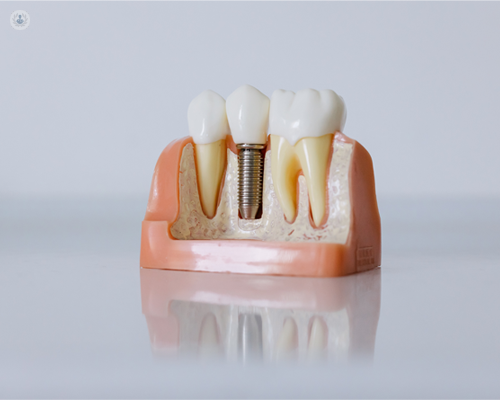Sinus lift
Dr Eduardo Crooke - Dentistry
Created on: 10-27-2022
Updated on: 01-18-2024
Edited by: Lauren Dempsey
What is the purpose of a sinus lift?
The sinuses are small, hollow spaces behind your cheekbones and forehead, connected to the inside of the nose. The bone inside the sinuses has a thin membrane lining.
A sinus lift, or sinus augmentation, is a surgical procedure that may be necessary for a successful dental implant. The bone in the maxilla (the part where the premolar and molar teeth are) must be strong and large enough to support a dental implant. If not, the membrane in the sinus cavity is lifted and the additional bone is placed underneath, hence the name, sinus lift. Over time, the new bone will fuse with the bone that’s already there.

When is a sinus lift needed?
There are a few reasons why a sinus lift might be necessary. If there is insufficient bone for an implant to anchor correctly, the implant can fail. But why would someone not have enough bone in their jaw? It might be that someone was born with large sinus cavities or a thin jawbone. Commonly, however, it is needed because of bone loss during one’s lifetime. Causes of bone loss include:
- aging
- periodontal diseases
- cancer of the mouth
- tooth loss in the upper jaw causing the reabsorption of bone
Your dentist will perform a clinical assessment to determine whether you will require a sinus lift before a dental implant. This will include an examination of the mouth, gum, and teeth, as well as imaging studies, such as an x-ray. Dental implants are often expensive so it is important to ensure everything is done to achieve optimal results.
What are the benefits of a sinus lift?
In addition to ensuring a more secure dental implant, the procedure can also improve the appearance of a sunken face, which may have resulted from tooth loss.
What bone is used for sinus lift?
To increase the amount of bone in the mouth, extra bone has to be added. There are different types of bone used for sinus lifts, differentiated by where they come from. The bone can either be your bone, from your mouth or elsewhere in your body, or from a cadaver or cow.
How is a sinus lift performed?
There are numerous different ways that a sinus lift can be performed. The approach chosen will depend on how much bone is already in the jaw, the type of bone graft that is used, and what approach will be used for the implant later on. It can either be performed using an external or internal approach.
Essentially, a small incision will be made in the tissue of the gum and this tissue will be raised to allow the surgeon access to the bone underneath. Here, a small cut will be made in the bone, which is raised into the sinus cavity, and the bone graft fills the gap remaining. The incision will then be closed with stitches.
Can a sinus lift and implant be done at the same time?
In rare cases that need mild sinus lifts, both procedures can be done simultaneously. Normally, they will be carried out separately, with a follow-up appointment a week or so following the sinus lift. Depending on the amount of extra bone used, the time between both procedures can vary from four to twelve months.

How painful is a sinus lift?
Most people will experience some discomfort but it is not a painful procedure. Before the procedure, you will be given either oral or intravenous sedatives or local anaesthetic, so you won’t feel anything during it. Over-the-counter painkillers can be taken to deal with pain in the gum post-operatively.
What are potential complications of a sinus lift?
After a sinus lift, the following side effects can be expected:
- swelling
- numbness from the anaesthesia
- bleeding from the nose or mouth
- infection
- sinuses may feel blocked
Antibiotics and anti-inflammatories may be given to help with swelling and infection respectively. Some more complex complications that can arise include:
During the procedure, the sinus membrane can tear, but it can be easily stitched up or covered with a patch. Sometimes, if the surgeon won’t be able to continue because the membrane can’t be repaired, then the surgery will have to be postponed.
If the body rejects the bone graft, this means the bone graft won’t develop its own blood supply. The procedure will have to be done again.
Acute maxillary sinusitis, the inflammation of the membrane, can also occur.
How much does a sinus lift cost?
The cost of the procedure depends on the complexity of the procedure, the size of the graft needed, and the material used, along with the fees your dentist or surgeon charges.
Is there an alternative to a sinus lift?
Possible alternatives to undergoing a sinus lift include:
- a short-term implant, or multiple short-term implants
- fewer implants placed further forward in the mouth if more than one at once
- angled implants
- bridges
- dentures
- zygomatic or pterygoid implants
As a sinus lift would be needed for a dental implant that would be placed toward the back of the mouth, one might opt not to replace the tooth, without it being very noticeable.
How long does a sinus lift last?
A week or so after the procedure has been done, the stitches will be removed and the healing process will be assessed. If the sinus lift is successful, it won’t need to be performed again before the dental implant.








